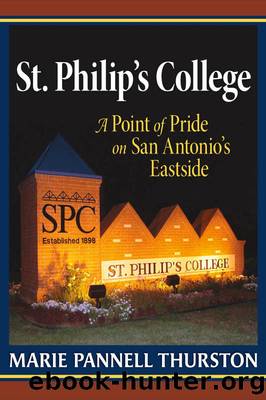St. Philip's College by Thurston Marie Pannell;Ferrier Maria Hernandez;Loston Adena Williams;

Author:Thurston, Marie Pannell;Ferrier, Maria Hernandez;Loston, Adena Williams;
Language: eng
Format: epub
Publisher: Texas A&M University Press
Published: 2012-08-15T00:00:00+00:00
Leonidas Watson
Clarence Hill, Mathematics, Adjunct Faculty
When Clarence Hill came to St. Philipâs, most of the buildings currently on the campus had not been built and according to him, the campus was small, housing only the Bowden Building and the gym. Hill recalled that âthere might have been a few shops down there; but, all of the offices were in the Bowden Building. Dr. Murphyâs office was there, Mr. Watsonâs office was there, and the Registrarâs office was there.â Hill began as a part-time instructor in 1968, and continued as adjunct faculty until he retired. Though recruited by Watson and offered a position in the day faculty, Hill did not accept, electing to continue with the evening faculty. âMany of us got started over here at St. Philipâs through Mr. Watson,â said Hill. âThere was a shortage in evening instructors at the time. I donât know why I never took him up on becoming a full-time staff member.â
The evening school culture differed from the day school in that the student body in the evening was a little older and somewhat more mature. Many of the evening school students worked during the day, attending school in the evening. Faculty in the evening division was limited to teaching two or three classes. One semester, Dean Watson said to Hill, ââBrother Hill, youâve got to take another class.â âI canât, Brother Watson, because you said that we canât,â replied Hill. âWell, Brother Hill,â Watson laughed, âI know what I said, but I also know that I can get a waiver for you.ââ
Hill described the faculty as âalmost like working in a high school.â Teachers were required to take classroom attendance and Watson required that that attendance be turned in each evening, before the faculty could leave the school. Watson wanted to know who was present, who was absent from the class, and where everyone was. Between 9:15 p.m. and 9:30 p.m., Watson sent a runner to check all of the classrooms to see who was present. If the room was unoccupied, the runner was to mark down that room number and turn it in to Watson.
Because some of the faculty had taught at four-year schools that had academic freedom, they expected the same at St. Philipâs, but Dean Watson said, âI donât care. If youâre supposed to be teaching a class from 6:45 to 9:45, I want the class there from 6:45 to 9:45.â
âFaculty that dismissed their classes at 7:30 and 8:00 didnât last long at St. Philipâs,â said Hill. Patricia WrightWilliams, who at the time was a work-study student for Dean Watson, echoed that she also recalled being told by Watson to run over to a specific classroom and see who was there. She recalled that sometimes instructors might take their class to a nearby restaurant and sometimes they failed to return, but woe to that instructor if Watson learned that the classroom was unoccupied.1
Browning McKinney Samples, Faculty Coordinator, Higher Education Achievement Program (HEAP)
Browning McKinney Samples, a former student who later became a faculty member, also began her tenure at St.
Download
This site does not store any files on its server. We only index and link to content provided by other sites. Please contact the content providers to delete copyright contents if any and email us, we'll remove relevant links or contents immediately.
| United States |
In Cold Blood by Truman Capote(3311)
The Innovators: How a Group of Hackers, Geniuses, and Geeks Created the Digital Revolution by Walter Isaacson(2849)
Steve Jobs by Walter Isaacson(2837)
All the President's Men by Carl Bernstein & Bob Woodward(2331)
Lonely Planet New York City by Lonely Planet(2173)
And the Band Played On by Randy Shilts(2131)
The Room Where It Happened by John Bolton;(2105)
The Poisoner's Handbook by Deborah Blum(2094)
The Murder of Marilyn Monroe by Jay Margolis(2059)
The Innovators by Walter Isaacson(2057)
Lincoln by David Herbert Donald(1947)
A Colony in a Nation by Chris Hayes(1881)
Under the Banner of Heaven: A Story of Violent Faith by Jon Krakauer(1750)
Amelia Earhart by Doris L. Rich(1650)
The Unsettlers by Mark Sundeen(1647)
Being George Washington by Beck Glenn(1628)
Birdmen by Lawrence Goldstone(1621)
Dirt by Bill Buford(1613)
Zeitoun by Dave Eggers(1594)
